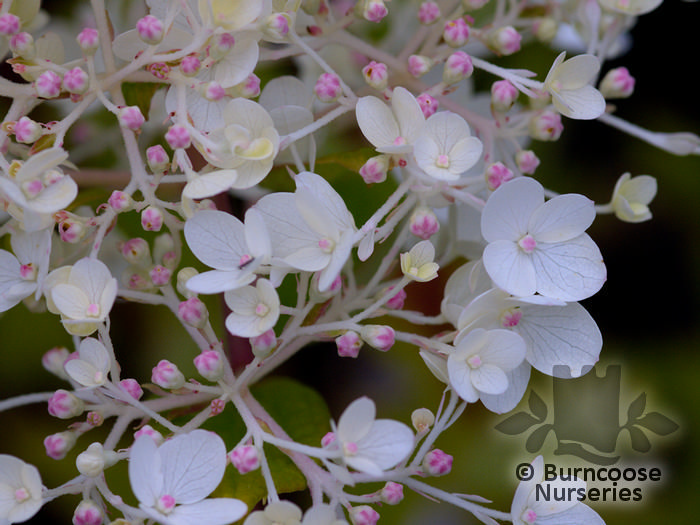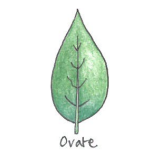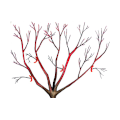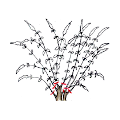Plants by mail order since 1984, over 4100 plants online today
Nursery & Gardens open: Mon - Sat 8:30 - 17:00 & Sun 10:00 - 16:00
Pop up café: open weather dependent
- Shop Now
- Burncoose Specialities
- This Month
- Offers & Promotions
- RHS Chelsea Flower Show 2024
- 40 years at Burncoose
- Engage With Us
- Information, Help & Advice
- About Us & Our Services
- Terms & Conditions
- Log In / Register
HYDRANGEA paniculata 'Grandiflora'
Commonly known as Hortensia
Large panicles of numerous white sterile florets in summer and autumn becoming deep pink
Further Reading....
-
DeciduousLarge, glossy, toothed, mid-green leaves.
-
 Shades of pinkAll shades of pink through to Carmine (red)In autumn
Shades of pinkAll shades of pink through to Carmine (red)In autumn -
 WhiteIn summer
WhiteIn summer -
 Height3-7m (10-23ft)
Height3-7m (10-23ft) -
 Spread2.5m (8ft)
Spread2.5m (8ft) -
Tall ShrubLarge flowerheads 20-20cm (8-12in) tall consisting almost entirely of sterile florets.
-
 Hardy - cold winterHardy in most places throughout the UK even in severe winters. May not withstand open/exposed sites or central/northern locations. Plant can withstand temperatures down to -15°C (5°F)
Hardy - cold winterHardy in most places throughout the UK even in severe winters. May not withstand open/exposed sites or central/northern locations. Plant can withstand temperatures down to -15°C (5°F) -
 Full sunRequires a sheltered site
Full sunRequires a sheltered site -
 Partial shade
Partial shade
HYDRANGEA paniculata 'Grandiflora'
- Details
- Description
- Mature Size
- Tips and Advice
- Goes Well With
- Planting Combinations
- Other Suggestions
- See Also...
-
Additional Features
 Good to knowTo produce larger flowerheads cut back previous season's shoots to within a few buds of the woody framework
Good to knowTo produce larger flowerheads cut back previous season's shoots to within a few buds of the woody framework Pests & DiseasesRed spider mites, scale insects, vine weevils, capsid bugs, grey mould(Botrytis), hydrangea virus, powdery mildew, leaf spot, honey fungus.
Pests & DiseasesRed spider mites, scale insects, vine weevils, capsid bugs, grey mould(Botrytis), hydrangea virus, powdery mildew, leaf spot, honey fungus. Place of originJapan. Collected by German botanist Phillipp Franz von Siebold 1859.
Place of originJapan. Collected by German botanist Phillipp Franz von Siebold 1859. -
Burncoose SpecialitiesHydrangeas
-
Flower ShapePanicles
-
Garden Location/ConditionsBorderSuitable for a large shrub border
-
HardinessFully hardy
-
Leaf margin
 Serrate
Serrate(see photos above) -
Leaf shape
 Ovate
Ovate(see photos above) -
Pruning group
 Pruning group 1Suitable for: Deciduous and evergreen trees, and some deciduous shrubs.
Pruning group 1Suitable for: Deciduous and evergreen trees, and some deciduous shrubs.
Pruning: Minimal pruning required. Prune wayward or crossing branches to maintain a healthy framework.
When: When dormant in the late winter/early spring. Some in the summer/autumn to prevent bleeding of sap.
 Pruning group 4Suitable for: Deciduous trees and shrubs that flower on current year's growth or are grown for winter stem effect.
Pruning group 4Suitable for: Deciduous trees and shrubs that flower on current year's growth or are grown for winter stem effect.
Pruning: Hard prune to a low permanent framework.
When: Annually in early Spring.
-
Seasonal InterestAutumnSummer
-
Soil ConditionsFertile moist well-drained soilHumus-rich
-
Toxic - Category C
 Harmful if eatenPets, i.e. cats, dogs, rabbits, rodents, notably dogs and cats
Harmful if eatenPets, i.e. cats, dogs, rabbits, rodents, notably dogs and cats May cause skin allergyPeople
May cause skin allergyPeople -
WildlifeRabbit Resistant
Jan
Feb
Mar
Apr
May
Jun
Jul
Aug
Sep
Oct
Nov
Dec
Hydrangeas - Care Guide
- Hydrangeas for everyone!
- Quick tour of hydrangea stocked - Video Tip ondemand_video
- Soil & Feeding
- Pruning Hydrangeas
- Pruning Hydrangeas - Video Tip ondemand_video
- Hydrangeas, keeping them blue - Video Tip ondemand_video
- Propagation
- Drying Flower Heads
- Drying hydrangea flower heads - Video Tip ondemand_video
- Popular Mopheads & Lacecaps
- Hydrangeas and other plants
- Further Reading
|
3-7m (10-23ft)
|
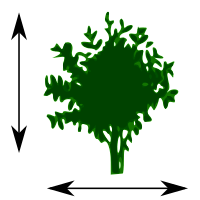
|

|
|
2.5m (8ft) |




















ACER palmatum 'Katsura'
Japanese maple
Available from £35.00

ACHILLEA 'Red Velvet'
Available from £12.50

AGASTACHE 'Blackadder'
Available from £13.50

AGASTACHE foeniculum 'Blue Fortune'
Anise hyssop
Available from £13.50

ARUNDO donax var. versicolor
Giant reed
Available from £17.50

CROCOSMIA 'Harlequin'
Available from £13.50

ECHINACEA 'White Meditation'
Available from £14.50

ELAEAGNUS x ebbingei 'Gilt Edge'
Available from £15.00

HYDRANGEA
Hortensia

HYDRANGEA 'Enziandom'
Mophead
Available from £15.00

HYDRANGEA 'Joseph Banks'
Mophead
Available from £15.00

HYDRANGEA paniculata 'Tardiva'
Available from £16.50

HYDRANGEA paniculata 'Vanille Fraise'
Available from £18.50

LAVATERA 'Barnsley'
Shrubby mallow
Available from £12.50

MAGNOLIA grandiflora
Bull bay, Loblolly magnolia
RHODODENDRON Harrow Hybrids

ROSA rugosa 'Roseraie de l'Hay'
Japanese rose, Hedgehog rose, Ramanas rose
Available from £13.50

SAMBUCUS nigra 'Black Beauty'
Common elder
Available from £16.00

SORBUS harrowiana
Available from £35.00

TAXUS baccata 'Fastigiata' 'Aureomarginata'
Irish yew
Available from £20.00

VIBURNUM betulifolium
Available from £18.50
Useful extras...

Fertilisers & Feeds - Vitax
Q4 Pelleted Fertiliser
A useful fertiliser suitable for use on a wide variety of plants. Q4 provides all the nutrients and trace elements essential for vigorous growth, abundant flowering and ripening of fruit.
3 options from £6.00
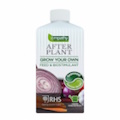
Fertilisers & Feeds - Empathy
Afterplant - Grow Your Own
AFTER PLANT GROW YOUR OWN seaweed is ready to use liquid concentrate that was specially formulated be used on all edible plants.
Only £8.00

Fertilisers & Feeds - Empathy
Afterplant - Tomatoes
AFTER PLANT TOMATO FEED Liquid Concentrate with Bio stimulant is a high potash liquid concentrate containing seaweed extract, plant derived amino acids and other nutrients specifically formulated to benefit tomatoes and greenhouse plants.
Only £8.00

Fertilisers & Feeds - Empathy
Rootgrow mycorrhizal fungi
Recommended by the RHS. Contains Rootgrow™ mycorrhizal fungi. Suitable for all trees and shrubs (except rhododendrons, azaleas, heathers, cranberries and blueberries)
3 options from £3.00

Fertilisers & Feeds - Empathy
Rootgrow Ericoid mycorrhizal fungi
This specially adapted Rootgrow™ mycorrhizal fungi will boost the growth of acid-loving plants like rhododendrons, azaleas, heathers and blueberries.
It contains ericoid and arbuscular mycorrhizal fungi, which are found in poor acidic soils where ericaceous plants naturally grow.
Only £7.50

Fertilisers & Feeds - Empathy
All-purpose Seaweed Stimulant
All-purpose organic concentrated seaweed feed that is a ready to use, derived from sustainable harvested kelp, that can be used on all outdoor and indoor plants, except acid loving plants.
Perfect used in conjunction with Rootgrow™.
Only £7.50


